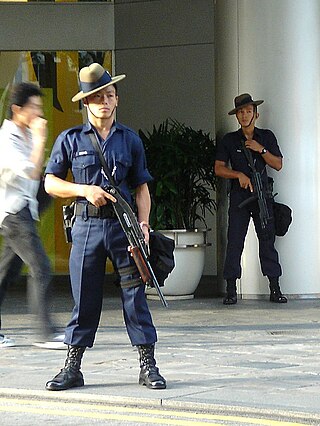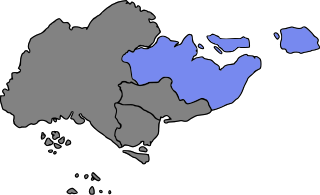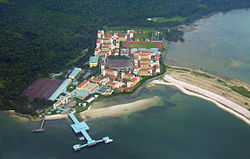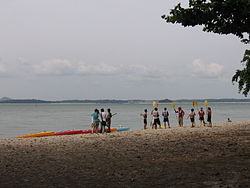
Changi is a planning area located in the geographical region of Tanah Merah in the East Region of Singapore. Sharing borders with Pasir Ris and Tampines to the west, Changi Bay to the southeast, the South China Sea to the east and the Serangoon Harbour to the north. Changi, excluding the two water catchments and islands of Singapore, is the largest planning area by land size.

Pulau Ubin, also simply known as Ubin, is an island situated in the north east of Singapore, to the west of Pulau Tekong. The granite quarry used to be supported by a few thousand settlers on Pulau Ubin in the 1960s, but only about 40 villagers remained as of 2012. It is one of the last rural areas to be found in Singapore, with an abundance of natural flora and fauna. The island forms part of the Ubin–Khatib Important Bird Area (IBA), identified as such by BirdLife International because it supports significant numbers of visiting and resident birds, some of which are threatened. Today, the island is managed by the National Parks Board, compared to 12 agencies managing different areas of the island previously.

Tanjong Chek Jawa is a cape and the name of its 100-hectare wetlands located on the south-eastern tip of Pulau Ubin, an island off the north-eastern coast of the main island of Singapore. Chek Jawa is among the last few places left in Singapore with a natural rocky shore.

Changi Village is a modern village situated at the northern tip of Changi which is at the eastern end of Singapore. It is the usual connecting point for travellers heading to Pulau Ubin or Malaysia by ferry. Fishermen in the kelongs located in the Serangoon Harbour offshore also use this jetty as a drop off point to come onto mainland. Changi Village also has many resorts and leisure facilities to cater for a weekend getaway for many Singaporeans. The area is classified by Urban Redevelopment Authorities as under the planning area of Changi and in the subzone of Changi Point. It is also classified under District 17 for property indexing.

The Gurkha Contingent (GC) is a line department of the Singapore Police Force (SPF) consisting primarily of Gurkhas from Nepal, who are meticulously recruited by the British Army with the purview of the Government of Singapore. The contingent's roles are as a special guard force and counter-terrorist force.
Pulau Tekong Reservoir is a reservoir located on the north west of Pulau Tekong, an island in Singapore. It is part of the North-Eastern Islands planning area.

The Basic Military Training Centre (BMTC) is a military training facility of the Singapore Armed Forces (SAF). It comprises five schools organised into three camps, of which two are based on Pulau Tekong, an island off the northeast coast of mainland Singapore, while the third camp is in Kranji in northwest Singapore. As its name indicates, it provides basic military training for the majority of recruits enlisted in the SAF.

The Malaysia–Singapore border is an international maritime border between the Southeast Asian countries of Malaysia, which lies to the north of the border, and Singapore to the south. The boundary is formed by straight lines between maritime geographical coordinates running along or near the deepest channel of the Straits of Johor.

Changi Beach Park is a beach park located at the northern tip of Changi in the eastern region of Singapore.

Pulau Sajahat, was a small island about 1.2 hectares located off the north-eastern coast of Singapore, near Pulau Tekong. The island, together with its smaller companion Pulau Sejahat Kechil, has been subsumed by Pulau Tekong with the land reclamation works on Pulau Tekong's southern and northwestern coasts.

Singapore Island, also known as mainland Singapore, is the main constituent island of the sovereign island country and city-state of the Republic of Singapore. It is located at the southern tip of the Malay Peninsula, between the Straits of Malacca and the South China Sea. The Singapore Strait lies to the south, while the Johor Strait lies to the north.
Singapore has about 65 species of mammals, 390 species of birds, 110 species of reptiles, 30 species of amphibians, more than 300 butterfly species, 127 dragonfly species, and over 2,000 recorded species of marine wildlife.

The North-Eastern Islands is a planning area and a group of islands located within the North-East Region of Singapore. The cluster is made up of three islands, namely Pulau Tekong, Pulau Tekong Kechil and Pulau Ubin. Pulau Tekong and Pulau Tekong Kechil was formerly home to 10 villages while Pulau Ubin was home to a number of granite quarries. At present, Pulau Tekong houses the Singapore Armed Forces Basic Military Training Centre while Pulau Ubin is one of the last areas in Singapore that has been preserved from urban development, concrete buildings and tarmac roads.

Serangoon Harbour is a harbour in Singapore located between the mainland island of Singapore and Pulau Ubin.

Pulau Sekudu, or Frog Island, is an islet located just off Chek Jawa on Pulau Ubin, Singapore. It lies in the Serangoon Harbour opposite Changi. Despite its proximity, it is only reachable by boat, even at low tides. One can see the islet directly opposite the Chek Jawa Visitor Centre.

Rural East Constituency was a constituency represented in the Legislative Council of Singapore from 1948 until 1951. It elected one Legislative Council member.
















